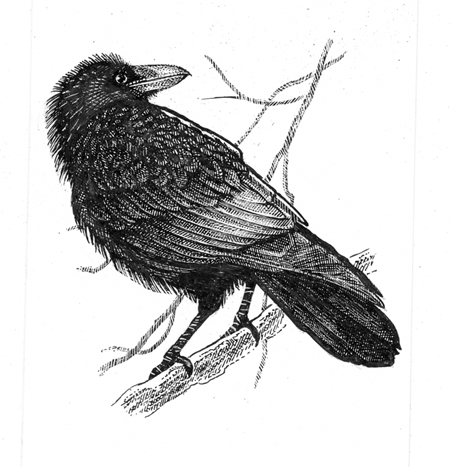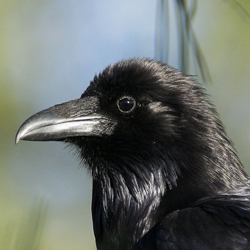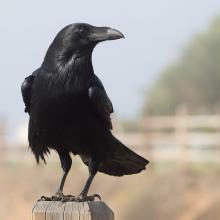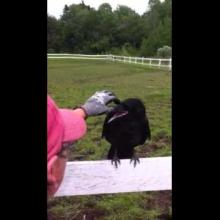

Join BirdNote tomorrow, November 30th!
Illustrator David Sibley and actor H. Jon Benjamin will face off in the bird illustration battle of the century during BirdNote's Year-end Celebration and Auction!
Eric Dinerstein shares these reflections on the Common Ravens that live near Cabin John, Maryland . . .
By October, most of the birds that breed in the East have taken wing to warmer climes — South Carolina, Florida, the Caribbean, Central America, or even the Peruvian Amazon — to pass the winter in places where bugs, caterpillars, and fruits are still plentiful. Only hardy species remain behind, well adapted, by dint of feathers and extra fat, to cope with the freezing temperatures and fierce winds of winter.

One of the pleasures of a crisp, clear November day in Cabin John is spotting a pair of large black birds roosting on the water tower’s railing at the top of the hill. Watching over us from that vantage point is the largest perching bird in the world, the Common Raven.
When it flies from its perch, it’s easy to distinguish a Common Raven from the ubiquitous crows of the neighborhood. Ravens are larger than crows and with a more robust bill and a longer, wedge-shaped tail. But it’s the vocalization that most memorably sets them apart: once you learn to recognize the raven’s loud croak, you will never forget it. And it’s a useful field ID to know. You can travel almost anywhere in the wilds of the northern hemisphere, from the coast of Siberia, to the slopes of Mt. Everest, across to Spain, and through much of North America down to southern Mexico, to find this species. The Common Raven has one of the widest ranges of any perching bird.
In the United States, the Common Raven was once a bird of the wilderness, but over the decades, it has made its way into areas where settlements are interspersed with forest. The first introduction many of us had to ravens was in Edgar Allen Poe’s most famous poem. But his take, both melodic and macabre, made the talking bird a frightening subject. Along with other members of their family (the Corvids), crows, jays, and magpies, ravens may be the most intelligent of all birds, and they have among the largest brains of any bird. The raven’s cultural significance is well established among tribes of Northwest Indians, who consider the bird a god figure and trickster. Perhaps in recognition of its cleverness, they include representations of the raven in their totems. I have also seen ravens in Bhutan, where it is the national bird and where the monarchs wear a crown depicting a raven.
Ravens pair for life and are long lived among wild birds, perhaps reaching 20 years of age. Their intelligence, wide global range, broad diets, and adaptability to a variety of habitats are some reasons why ravens, crows, jays, and magpies are so abundant. But Nature always has surprises in store. In 1999, the first instance of West Nile Virus (WNV) was recorded in the US. The disease affected many bird species, but especially hard hit were members of the Corvid family. Many birds simply disappeared, to the consternation of ornithologists. By 2002, WNV had become widespread in the eastern US, and for a while, it was difficult to find even the once-ubiquitous crows, let alone a raven.
Somehow, our neighborhood ravens survived, or their offspring did, or a new pair moved in to take the place of the departed. Either way, we should be delighted to have them back. And for the record, I prefer the wild raven’s deep croak — the sound of wilderness — to the talking version’s “Nevermore.”
###
Check out these BirdNote shows about the Common Raven.

Ravens and Crows Who's Who
Tony Angell on the Raven
How the Raven Made the Tide
Raven and the Winding River
Raven and the Sun, A Myth
Ravens and Wolves
The Royal Ravens
Raven's Love Song
Raven, Dog, Bone
Stay up to date with Corvid Research
Originally authored December 20, 2014. Adapted from an article that originally ran in The Village News.






